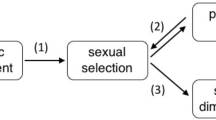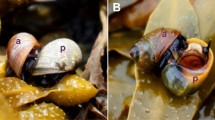Abstract
HAMILTON and Zuk1 proposed that elaborate secondary sexual characters may have evolved because they act as cues in mate choice by revealing the health of a potential mate. From this theory, they derived the prediction that species which are more liable to parasitic infection should possess well-developed secondary sexual characters. They went on to demonstrate a positive association between prevalence of haematozoa and plumage brightness across species of North American passerine birds. Subsequent analyses by one of us2 on the same colour data confirmed that the relationship with male brightness existed even when the effects of phylogenetic associations were taken into account. The relationship was also found across European passerines when behavioural and ecological correlates of colour and phytogeny were accounted for2. Here, using independently derived plumage brightness scores, we question these conclusions.
This is a preview of subscription content, access via your institution
Access options
Subscribe to this journal
Receive 51 print issues and online access
$199.00 per year
only $3.90 per issue
Buy this article
- Purchase on Springer Link
- Instant access to full article PDF
Prices may be subject to local taxes which are calculated during checkout
Similar content being viewed by others
References
Hamilton, W. D. & Zuk, M. Science 218, 384–387 (1982).
Read, A. F. Nature 327, 68–70 (1987).
Field Guide to the Birds of North America, 2nd edn (National Geographic Society, Washington, 1987).
Ridley, M. The Explanation of Organic Diversity (Clarendon, Oxford, 1983).
Pagel, M. D. & Harvey, P. H. Q. Rev. Biol. 63, 413–440 (1988).
Baker, R. R. & Parker, G. A. Phil. Trans. R. Soc. B 287, 63–130 (1979).
Peterson, R., Mountfort, G. & Hollom P. A. D. A Field Guide to the Birds of Britain and Europe. 4th edn (Collins, London, 1983).
Read, A. F. in Parasitism and Host Behaviour (eds Barnard, C. J. & Behnke, M.) (Taylor and Francis, London, in the press).
Harvey, P. H., Read, A. F., John, J. L., Gregory, R. & Keymer, A. E. in Parasitism: Coexistence or Conflict? (eds Aeschlimann, A. & Toft, C.) (Oxford University Press, in the press).
Zuk, M. in Ecology, Behaviour and Evolution of Bird-Parasite Interactions (eds Loye, J. E., Van Riper, C., & Zuk, M.) (Oxford University Press, in the press).
Author information
Authors and Affiliations
Rights and permissions
About this article
Cite this article
Read, A., Harvey, P. Reassessment of comparative evidence for Hamilton and Zuk theory on the evolution of secondary sexual characters. Nature 339, 618–620 (1989). https://doi.org/10.1038/339618a0
Issue Date:
DOI: https://doi.org/10.1038/339618a0
This article is cited by
-
The interspecific relationship between prevalence of blood parasites and sexual traits in birds when considering recent methodological advancements
Behavioral Ecology and Sociobiology (2012)
-
Meta-analysis and research on host–parasite interactions: past and future
Evolutionary Ecology (2012)
-
The influence of female viability differences on the evolution of mate choice
Heredity (1996)
-
Parasites and carotenoid-based signal intensity: How general should the relationship be?
Naturwissenschaften (1996)
-
Do bright colors at nests incur a cost due to predation?
Evolutionary Ecology (1996)
Comments
By submitting a comment you agree to abide by our Terms and Community Guidelines. If you find something abusive or that does not comply with our terms or guidelines please flag it as inappropriate.



